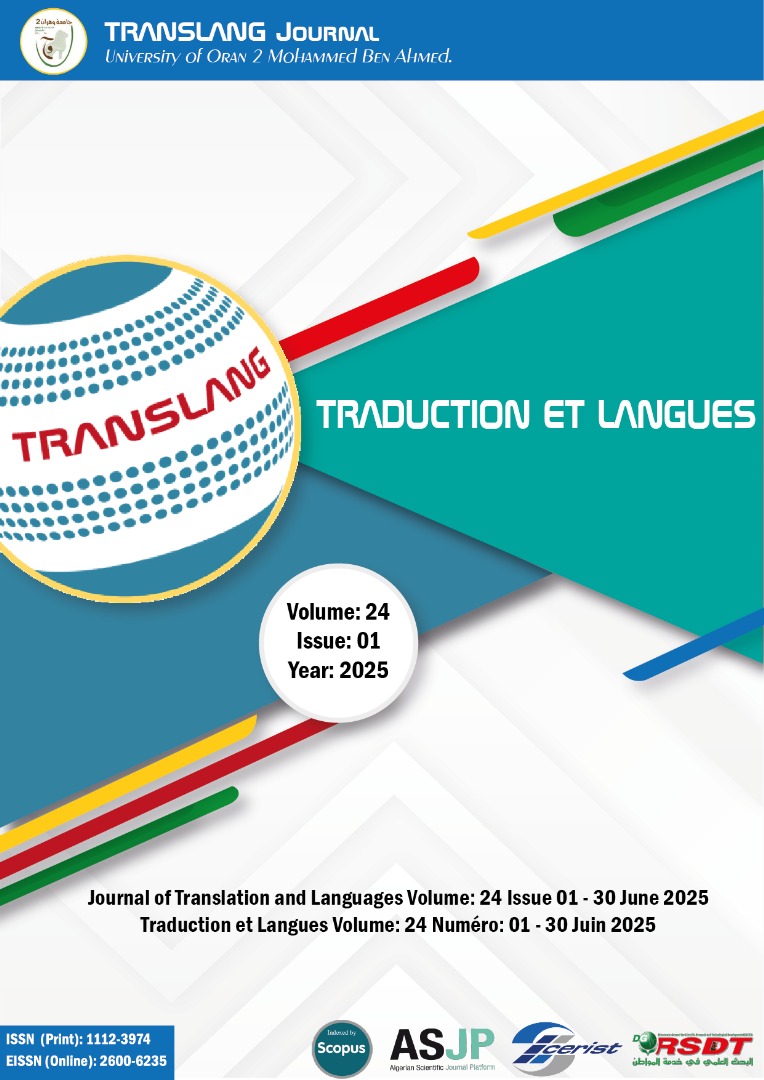Entre mundos: espacio, movimiento e imagen en “Le Chameau et les Bâtons Flottants”. Una aproximación paratraductiva y multimodal Between Worlds: Space, Motion, and Image in Le Chameau et les Bâtons Flottants: A Paratranslational and Multimodal Approach
Main Article Content
Abstract
This study examines Jean de La Fontaine’s fable Le Chameau et les Bâtons Flottants from two interrelated perspectives: the verbal and the visual. Our analysis focuses on the dynamic interaction between the original text and its illustrations, including later translated and adapted versions. We investigate how visual representations do more than merely accompany the written narrative; they actively contribute to reshaping and expanding its meaning. The illustrations serve as interpretive tools that mediate the reader’s understanding of key themes, character dynamics, and spatial configurations. From a visual standpoint, particular attention is given to how illustrations change across translations, revealing cultural variations in the representation of space and movement. These modifications are not neutral; they influence the reader’s perception of the fable’s setting and the symbolic implications of its narrative. This phenomenon is explored through the lens of paratranslation, a concept that emphasizes how translation encompasses not only linguistic transfer but also the adaptation of visual and spatial elements. Within this framework, the fable’s images emerge as a crucial site of cultural negotiation, where physical and symbolic spaces are reimagined. By analyzing various illustrated editions (including the notable Russian version with Marc Chagall’s artwork), we observe how certain illustrations reinterpret or even omit narrative elements, thus generating new layers of meaning. The absence, for instance, of the camel in Chagall’s image challenges the textual focal point and prompts a reconfiguration of narrative space and emotional tone. Ultimately, this research argues that illustrated versions of the fable construct a multimodal discourse in which text and image co-create meaning. The visual adaptations not only reflect but also reshape the fable’s didactic function by mediating cultural codes and aesthetic sensibilities. Through this comparative, paratranslational approach, we highlight the transformative role of visuality in literary transmission, offering a deeper understanding of how narrative space, perception, and cultural identity are negotiated across languages and artistic media.
Metrics
Article Details
References
Bhabha, H. K. (1994). The location of culture. Routledge.
Chagall, M. (ca. 1955). Le Chameau et Les Bâtons Flottants [Grabado]. En Fables de La Fontaine. Artsy. https://www.artsy.net/artwork/marc-chagall-le-chameau-et-les-batons-flottants-plate-44-from-fables-de-la-fontaine
Creswell, J. W., & Poth, C. N. (2018). Qualitative inquiry and research design: Choosing among five approaches (4th ed.). Sage Publications.
Cruz García, L. (2001). La traducción de textos publicitarios. Los anuncios de productos informáticos. Tesis doctoral, Universidad de Las Palmas de Gran Canaria.
Derrida, J. (1967). De la Grammatologie (G. C. Spivak, Trad.). Johns Hopkins University Press.
Denzin, N. K. (2017). The research act: A theoretical introduction to sociological methods (5th ed.). Routledge.
Derrida, J. (1997). Monolingualism of the Other: Or, the Prosthesis of Origin. (Traducción al español: Monolingüismo del otro: o la prótesis de origen). Stanford University Press.
Einstein, A. (1920). Relativity: The Special and General Theory (R. W. Lawson, Trans.). Methuen & Co.
Feng, W. D., & Xing, C. (2023). Multimodal intertextuality and persuasion in advertising discourse. Discourse & Communication, 17(1), 3-24. https://doi.org/ 10.1177/17504813221133556
Ferreiro Vázquez, Ó. (Ed.). (2022). Avances en las realidades traductológicas: tecnología, ocio y sociedad a través del texto y del paratexto. Peter Lang.
Ferreiro Vázquez, Ó. (2015). Traducir e interpretar lo público. Editorial Comares.
Forceville, C. (2005). Visual representations of the idealized cognitive model of anger in the Asterix album La Zizanie. Journal of Pragmatics, 37(1), 69-88. https://doi.org/10.1016/j.pragma.2004.08.004
Flick, U. (2014). An introduction to qualitative research (5th ed.). Sage Publications.
Foucault, M. (1970). La arqueología del saber. Ediciones Siglo XXI.
Genette, G. (1980). Narrative Discourse: An Essay in Method (J. E. Lewin, Trans.). Cornell University Press.
Groensteen, T. (2007). The system of comics. University Press of Mississippi.
Kaindl, K. (1999). Thump, Whizz, Poom: A framework for the study of comics under translation. Target, 11(2), 263-288. https://doi.org/10.1075/target.11.2.07kai
Kress, G. (2010). Multimodality: A social semiotic approach to contemporary communication. Routledge.
La Fontaine, J. de. (1897). Fables de Jean de la Fontaine (Illustrations de Vimar). Alfred Mame et Fils.
La Fontaine, J. de. (trad. Chumina, O.) (1985). Fábulas de La Fontaine en las traducciones. Editorial “Literatura artística”.
Li, B., Lv, C., Zhou, Z., Zhou, T., Xiao, T., Ma, A., & Zhu, J. (2022). On vision features in multimodal machine translation. Proceedings of the 60th Annual Meeting of the Association for Computational Linguistics, 6327–6337. https://doi.org/ 10.18653/v1/2022.acl-long.438
Lefevere, A. (1992). Translation, Rewriting, and the Manipulation of Literary Fame. Routledge.
Lotman, J. (1990). Universe of the Mind: A Semiotic Theory of Culture (A. Shukman, Trans.). I.B. Tauris.
Lotman, Y. M. (1996). La semiosfera: Semiótica de la cultura y del texto. Ediciones Cátedra.
McCloud, S. (1993). Understanding comics: The invisible art. HarperCollins.
Mignola, M., & Roberson, C. (2018). Rasputin: The Voice of the Dragon. Dark Horse Comics.
Meilán, P., & Díez-Platas, F. (s.f.). De texto con imágenes a imágenes con texto: La confusa transformación de las Metamorfosis ilustradas en la primera mitad del siglo XVI.
Patton, M. Q. (2015). Qualitative research & evaluation methods (4th ed.). SAGE Publications.
Pöchhacker, F. (2021). Multimodality in interpreting. In Y. Gambier & L. van Doorslaer (Eds.), Handbook of Translation Studies (Vol. 5, pp. 151–157). John Benjamins.
Ricoeur, P. (1984). Time and Narrative, Volume 1 (K. McLaughlin & D. Pellauer, Trans.). University of Chicago Press.
Ryan, M.-L. (2001). Narrative as Virtual Reality: Immersion and Interactivity in Literature and Electronic Media. Johns Hopkins University Press.
Schurster, K., & Ferreiro-Vázquez, Ó. (2025). Traducción y paratraducción 4.0: Análisis sobre la reificación en el mundo de la inteligencia artificial. Cadernos de Tradução, 45, 1–21. https://doi.org/10.5007/2175-7968.2025.e102146
Yuste Frías, J. (2008). Pensar en traducir la imagen en publicidad: El sentido de la mirada. Pensar la Publicidad. Revista Internacional de Investigaciones Publicitarias, 2(1), 141-170.
Yuste Frías, J. (2023). Traducir texto y paratraducir imagen entre la cultura del libro y la cultura de las pantallas. Cadernos de Tradução, 43(1), 1–46. https://periodicos. ufsc.br/index.php/traducao/article/view/95405
Zabalbeascoa, P., & Voellmer, E. (2014). Paratraducción y la gestión de la traducción en los medios audiovisuales. Peter Lang.
